

Eyes All Around « translinguistic other. This week on the Harper’s Magazine blog, Scott Horton muses about the philosophical significance of the convex mirror at the vanishing point of Jan Van Eyck’s Arnolfini Portrait.
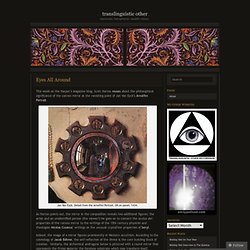
Jan Van Eyck. Detail from the Arnolfini Portrait. Oil on panel, 1434. As Horton points out, the mirror in the composition reveals two additional figures: the artist and an unidentified person (the viewer?) He goes on to connect the oculus dei properties of the convex mirror to the writings of the 15th century physicist and theologian Nicolas Cusanus‘ writings on the unusual crystalline properties of beryl. Indeed, the image of a mirror figures prominently in Western occultism. Illustration from S. It is an oft-romanticized fact that Van Eyck was an alchemist. Nowhere is Van Eyck’s alchemical achievement more gloriously demonstrated than The Adoration of the Mystic Lamb, the lower central panel of the Ghent Altarpiece, a painting begun by his brother Hubert and completed by Jan upon the elder Van Eyck’s death.
Motherhood From Spirit and Water. I recently watched a movie on 12th Century Christian Benedictine Abbess, mystic, nun, writer, artist, herbalist, musician and prophetic visionary and healer Hildegard von Bingen, whose mandalas are above (the first is entitled Awakening, the second Motherhood from Spirit and the Water, and the third Cultivating the Cosmic Tree…).
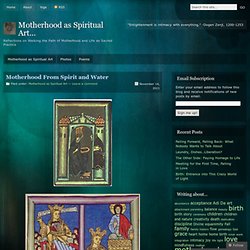
What strikes me so deeply about her story and her life’s work is how much she was able to do as a woman in one lifetime – and during a time when a woman’s power in Europe was scant. She found a way to divinely illuminate a feminine spirituality that was embodied and earth-based. Her message reminds me that the archetype of Motherhood transcends giving birth. Here is a woman who was visionary, mystic, healer, caregiver and creative artist all at once. Opening herself to awakening and perceiving the interconnectedness of all things, a profound Vision guided her life. She led me to think on ‘Vision‘- and what it means in my own life. Like this: Art Project. Art Through Time: A Global View - The Ecstasy of St. Teresa. Born in the Castilian town of Ávila in 1515, Teresa Sánchez de Cepeda y Ahumada entered a Carmelite convent around the age of twenty, but it was not until the 1550s that she began to experience divine visions like the one to which Gian Lorenzo Bernini gives tangible form here.

Located above the altar of the Cornaro Chapel in Rome’s Santa Maria della Vittoria, Bernini’s The Ecstasy of St. Teresa represents an episode from the life of the saint as recorded in her spiritual autobiography. Teresa describes an angel carrying a fire-tipped spear with which he pierces her heart repeatedly, an act that sends her into a state of spiritual rapture. “The pain,” she writes, “was so severe that it made me utter several moans. The sweetness caused by this intense pain is so extreme that one cannot possibly wish it to cease, nor is one’s soul then content with anything but God.” Dress (Ball Gown) L’interdit biblique du second commandement du Décalogue - Protestantisme et images.
« Tu ne te feras pas d’image... » Ex 20, 1 - 4 (Dt 5, 6-9) « Tu ne te feras pas d’images [1] ». Cet interdit biblique du second commandement [2] a imprégné la conscience - et même l’inconscient - de générations de protestants réformés. Comme les 9 autres commandements, il fut appris par cœur par des générations de catéchumènes, récité par l’assemblée chaque dimanche ; on le trouve souvent peint ou gravé à l’intérieur de nos temples. La Réforme et les images. Origine et actualité (1) - Protestantisme et images. Le protestantisme est-il une religion sans images ?
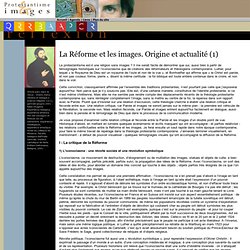
Il me serait facile de démontrer que oui, aussi bien à partir de témoignages historiques sur l’iconoclasme que de citations des réformateurs et théologiens contemporains. Luther, pour lequel « le Royaume de Dieu est un royaume de l’ouïe et non de la vue », et Bonhoeffer qui affirme que « le Christ est parole, et non pas couleur, forme, pierre », disent la même certitude : la foi biblique est toute entière contenue dans le croire, et non dans le voir.
La Réforme et les images. Origine et actualité (2) - Lecture d'images produites par la Réforme - Protestantisme et images. III.
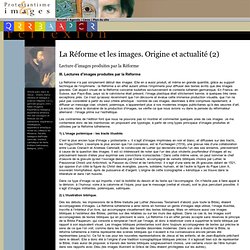
Women Artists of the Renaissance - Les cahiers d'Alain Truong. Renaissance Europe was not a promising place for female artists to emerge.
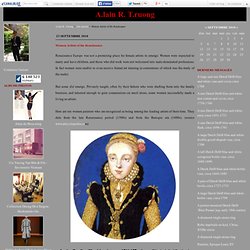
Women were expected to marry and have children, and those who did work were not welcomed into male-dominated professions. In fact women were unable to even receive formal art training (a cornerstone of which was the study of the nude). But some did emerge. Privately taught, often by their fathers who were drafting them into the family business, and talented enough to gain commissions on merit alone, some women successfully made a living as artists. Here are ten women painters who are recognized as being among the leading artists of their time.
Analyser une oeuvre d'art contemporain. Vidéos Histoire des Arts. Arte Ricerca. Smarthistory: a multimedia web-book about art and art history. The National Gallery, London: Western European painting 1250–1900.